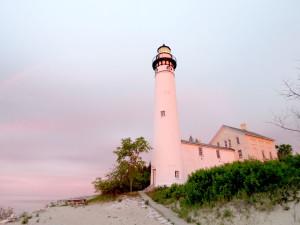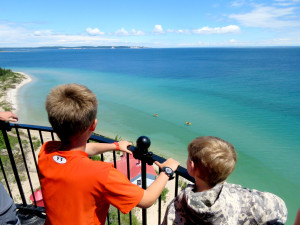By David Fleet
Editor

Leland-For about the past month Jonathan Schechter had a room with a spectacular view.
From May 24 until June 28 Schechter, a Brandon Township resident and on-call firefighter, served as the lighthouse keeper on South Manitou Island.
He was one of three individuals selected by the National Park Service for the month-long stint to run the working maritime feature on northeastern Lake Michigan, about 7 miles off the coast of Leland—part of Leelanau County and the Sleeping Bear Dunes National Lakeshore. The small island is about 3 miles by 3 miles and features Florence Lake along with a system of trails and campsites. The island is accessible by the Manitou Island Transit from Leland that makes the trip over and back once per day in the summer months.
“My job as lighthouse keeper was to greet the boats when they would come in each day and take people up in the lighthouse if they wanted to climb up,” he said.
The small island is significant in Michigan history due to a unique natural deep water port known as Crescent Bay—the only such feature between Chicago and Buffalo, NY. So important is the location that in 1838 Congress OK’d $5,000 for the construction of the first lighthouse to help ships navigate the often turbulent waters of the Manitou Passage.
In 1871 a second lighthouse was built due to the shipping traffic and the number of wrecks in the area. The 100-foot lighthouse, which according to the Sleeping Bear Dunes National Lakeshore historians is 18 feet in diameter at the base, was in full operation until 1958.

“Many came out here just to see a Great Lake lighthouse,” Schechter said. “There are 117 steps that turn around a center pole to the top. Going up was not bad, but coming down some had difficulty.”
Electricity to the lighthouse and other buildings is supplied by solar panels on the roofs of buildings.
Schechter said while the island remains pristine— debris frequently washes up on the shoreline.
“A lot of fishing lures and line,” he said. “Plastic items such as water bottles and Mylar balloons are pretty common. There was a United States Navy buoy that came in while I was there. Many bits and pieces of old shipwrecks are also scattered on the shore line. There’s an estimated 50 shipwrecks nearby so it’s no wonder why so many items end up on the island.”
According to the Sleeping Bear Dunes National Lakeshore historians, in 1960 the ship Francisco Morazan ran over the wreck bulk freighter Walter L. Frost which went down in November 1903 and
became grounded about 300 feet off the south shore of the island.
“Part of the ship can still be seen from the island,” he said. “The rough water in the passage is really still an issue today. Twice during my time on the island the boat from Leland did not make the trip over to the mainland. We had kayakers come over from the mainland, but it is very risky—the water is way too cold and the weather can change quickly.”
Schechter said there are two cemeteries on the island.
“We assume the unmarked graves are shipwreck victims,” he said. “Keeper Aaron Sheridan, his wife and their infant on March 15, 1878 died in a boating accident near the lighthouse. They are buried on the island.”
While serving as keeper, Schechter lived in a farm house owned by the National Park Service built about 1840. He brought over most of his own food; however, the daily ferry would bring food items from the mainland if needed.
“Nighttime on the island is spectacular,” he said. “It’s very dark. No light pollution, so the stars go right over the horizon. The island is also a designated wilderness by the park system that limits usage—so camping and hiking are in specific areas. There are no bear, no deer and no raccoons. There are coyotes, hognose snakes and ‘Manitou Tigers’—or chipmunks that get into everything. I saw two bald eagles and bobcat tracks on the island.”
Located on the southwest side of the island is a grove of virgin white cedar trees.
Larger North Manitou Island is located about 4 miles north of South Manitou Island and is also accessible by ferry.
“If you go to the island keep in mind it’s still very rugged.”
